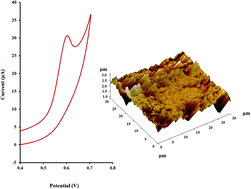A sensitive sensor based on molecularly imprinted polypyrrole on reduced graphene oxide modified glassy carbon electrode for nevirapine analysis†
Abstract
A molecularly imprinted polymer (MIP) sensor was offered for nevirapine (NVP) analysis based on the electropolymerization of pyrrole (Py) on electrochemically reduced graphene oxide (ErGO) immobilized on a glassy carbon electrode (GCE). Electrochemical impedance spectroscopy (EIS), scanning electron microscopy (SEM) and atomic force microscope (AFM) were applied to characterize the proposed sensor (MIP/ErGO/GCE). The electrochemical operation of this sensor for NVP analysis was tested using differential pulse voltammetry (DPV) and cyclic voltammetry (CV) methods in an alkaline medium. The prepared MIP/ErGO/GCE exhibited better analytical performance than other modified electrodes toward NVP detection. The offered sensor depicted a linearity range between 0.005 µM and 400 µM with a limit of detection (LOD) of 2 nM under optimal conditions. Notably, the offered sensor illustrated excellent selectivity, good reproducibility, acceptable repeatability, and reliable long-term performance. These experiments depicted the constructed sensor as a favorable and good sensing element towards NVP monitoring in pharmaceutical and serum samples.



 Please wait while we load your content...
Please wait while we load your content...